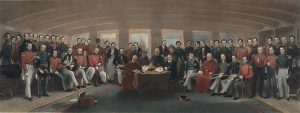Thomas Peace and Conor Wilkinson
As the first in a series of “unequal treaties” between the Qing dynasty and European powers, the 1842 Treaty of Nanjing marked an end to the first Opium War.
The Opium Wars marked the coming together of two interrelated phenomena in Britain’s imperial history. First, as British influence deepened in India, opium became an important part of the British East India Company’s exports. Second, as Britain industrialized, its move to steam technology gave it advantages unmatched by any other power. Together, these factors set the stage for this 1842 “agreement.”
In granting the British East India Company the power to collect revenue from Bengal, Bihar, and Orissa, the Company gained access to some of the richest opium producing regions in the world. Long a well-established drug – with global influence – China served as an especially large market for the drug. In the decades following the Treaty of Allahabad, the British tightened their control over opium production and increased its export to China. For the first time, with the trade in opium, Europeans were able to reverse a longstanding trade imbalance, making it easier to access Chinese tea and manufactured goods such as porcelain.
By the 1830s, China had two problems. In addition to the economic imbalance that had developed, millions of people – from all levels of society – were addicted to the drug. Over the course of the eighteenth century, Qing officials issued edicts outlawing the trade, but contraband – much of it fueled by the British East India Company warehouses in Gaungzhou – thrived. In 1839, after a near ten-fold increase in the trade, Chinese authorities cracked down, confiscating and destroying all of the opium in Gaungzhou.
Violence broke out and, upset over their losses, British traders petitioned the government to send troops to seek reparations for their losses. British merchants also had other interests, however. Foreign trade in China was tightly regulated. Only one port, the southern city of Guangzhou (Canton), was open to European traders. In requesting military intervention, the British East India Company hoped to gain greater access to Chinese markets and suppliers.
In 1840, a British flotilla arrived in the region. One of the ships, the Nemesis, had been kept secret. Iron-hulled, steam-powered, and with a shallower draft than conventional ships, the vessel was less dependent on weather conditions and could travel further upriver. The technology was a game changer.
As you read through the treaty, ask yourself the following questions:
- What is the relationship established between the Qing Dynasty and the British Empire?
- What impact do you think this treaty might have had on China?

This module was last modified in October 2022.
